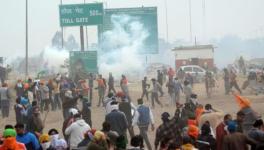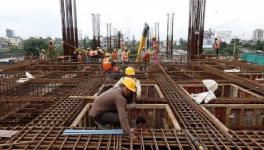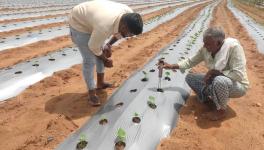‘Policy Makers Should Focus on Agri, Not Treat it Like Charity’
Pronab Sen.
Will the recent ‘packages’ announced by the government make a difference to the economy?
They will not. These steps, particularly bank re-capitalisation, have been pending for quite a while. Maybe we were in dire straits and now we are back to square zero; which is at the beginning of from where we got into the dire straits. Therefore the recent announcements have not made a difference.
Just like after the annual budget, there is jubilation again, especially in the middle class. There is talk about renewed GDP growth, lower fiscal deficit...
I don’t think the entire middle class is overjoyed. The middle class has at least two parts; the old middle class of people who have always been in that class. The much larger segment is of those who are moving into the middle class now. We call them the lower middle class, but they include those joining the middle class and then entering its upper sections. It is this large section that has been the big driver of the [economic] discourse. This is the really aspirational class. Their discourse really, really matters.
How has that discourse mattered to India In particular their obsession with GDP growth, inflation and fiscal deficits.
The middle class grew really slowly until the early nineties, after which it accelerated. From 2002 or so, it really zoomed. For these people the GDP is important because it defines the size of the cake to which they are aspiring. But it was also because employment was supposedly linked to GDP. The GDP became a proxy for employment opportunities. Remember, the characteristic of the middle class is not so much what it is doing itself but what it expects its children to be doing. This is true even for the old middle class. They aspire for their children to reach an economic level higher than their own.
Why draw the connection between GDP growth and employment opportunities?
It is established that when income is growing, presumably, jobs are growing. Since the job data would come five years later, one did not really know. Still, this connection worked. In the high-growth phase from 2002-2011, there seemed to be a pretty decent link between growth and jobs. When job expectations became pretty positive people were happy. But—and here is the big but—corporate India has been steadily moving towards technology upgradation and more capital-intensive production methods. Thus, the link between GDP growth and employment is weakening steadily. This has still not been factored in. They can see that job opportunities don’t seem to be around, that their children don’t seem to be getting the kind of jobs [they expect]. This is why there is actually a fair amount of worry.
What about the other elements in the middle class discourse—inflation and fiscal deficit?
Inflation has always been a cause for concern in India. Our work in the late seventies and early eighties suggested that the Indian public’s inflation threshold was about 6%.
Would that still be valid?
Yes, 5 to 6% inflation is still the comfort zone. Since income typically grows by 5-6% annually, inflation of the same magnitude is not seen as eroding income. Between 2004 and 2013, when inflation was at 9-10%, with food inflation in the double digits, it became an issue. Also, fiscal deficit was seen as important because if growth is essentially seen as something to be driven by private investment, then this deficit would constrain the savings available for it. The fiscal deficit was seen as the government preempting money for whatever expenditure it wanted to undertake. But there is an ambivalence here. A lot of the money that the government spends is to try and support the poor, and the middle class does not see any virtue in that, other than a sort of ethical virtue. As far as they are concerned, this expenditure doesn’t matter, which is short-sighted of them. It ultimately ties in with middle class aspirations, which are also for the next generation. The way they see to that is growth and the way to that is by holding down prices and deficit. That is the narrative you see everywhere.
With GDP growth at 7%, fiscal deficit low and inflation 3%, why is the middle class still unhappy?
The trouble is that economists tend to boil down extremely complex things into simple measurable things like GDP growth or inflation, without really explaining the complexities. The middle class is not thrilled and the complexity of economics comes in here. The middle class may ignore the farmer and the people who work in the informal sector, but the fact is that the GDP growth they desire requires demand to rise in pace with production. If you just accumulate inventories you will make losses and close shop.
Which is what is happening now...
Yes. Where will this demand come from? A part of it from the middle class with its higher income but this constitutes only 20 to 25% of India’s population. Below that are 75-80% of people, of whom 40% are in agriculture. That’s your potential consuming class. Incomes of these people have to grow in order to enable them to consume what you are producing. Without that, your growth will dip because you are not going to be able to sell your products.
Is this why Maruti is not doing well?
Maruti was growing very fast but the composition of Maruti’s growth was not the entry-level Maruti 800 model. Its growth came from the Swift and Dzire models, which cost a good Rs2-4 lakh more. First, the existing middle class was buying cars but new entrants into the car-owning population slowed down. Now, we are in a situation where there are still no new car buyers while the current middle class is saturated.
Those who bought cars five years ago should be ready for an upgrade or switch?
Yes, but think of what is happening: The car companies were growing at 7-8% and then suddenly spike up to 20%. Now, that 20% comes from the replacement. This is still taking place at 7-8%.That is how the peak has come to a crash. Between 2008 and 2012, they expanded production. Then the focus was on capturing market share. Now it is back to the normal.
Did Indians overestimate the size and purchasing power of the car-buying segment?
I don’t think we thought about it. We assumed that the consumption was continuing to go up, as it did between 2002 and 2011. And we pretended that that is continuing to happen even when it was not. Actually, this dip is the surest sign of what is happening to farmers. The agriculture sector is only 16% of GDP, but it engages 40% of the population, and accounts for nearly 45% of total consumption. The agriculture sector is in itself small but we forget that it supports a whole range of non-agriculture extremities which are totally dependent on it.
With 40% people supported by 16% of national income means that this 40% has a rather very low standard of living.
Yes, that is the big problem; but we forget that this section consumes a very high proportion of its income. Their savings are very low, at most 5% of income, while middle class savings are 35% of income. Agriculture is showing the clearest, most visible signs of the distress, because that is where prices are most flexible—you can see agricultural prices drop and go into negative territory. Nevertheless, distress is also present in the rest of the informal economy. This is partly because of the problems of agriculture, on which lots of the informal sector depends. And agriculture consumes a huge amount of services. All of that is distressed. So the distress level is not the 40%, it is probably 60-65% of the population after including those whose incomes depend on agriculture.
In the election results there is no sign of distress...
That is really quite amazing. Clearly Indians don’t think economics is that important.
OK, but there is one way in which people are making economic connections and that is the demand for government jobs.
The desire for government jobs used to be a big middle class thing earlier. In the 2000s, government jobs became less attractive to them than private sector jobs. Now the narrative seems to be changing again – people are again demanding government jobs. This, too, is a sign of distress.
Is it always so?
It always is a sign of distress. It was so in the sixties, seventies and eighties. It is back again.
What you are saying is that the situation is worse for sections other than the middle class?
The growth we are seeing is being captured only by the middle class. There is no growth trickling down at all. That is where distress lies. The [old] middle class’s incomes are okay. The problems are with the prospects of their children. Those are not great. The level of uncertainty within the old middle class has gone up as the number of people in the overall middle class has grown, because the competition for jobs that it took for granted has increased hugely.
The primary insecurity is that money finishes very quickly when you are not earning it and you want more for the next generation.
Very quickly, yes.
What should the middle class do in times of uncertainty? Is the savings rate really going down?
In fact, in a situation like that you should actually be saving more and spending less, on everything, particularly non-essentials.
How do you define essential?
This is precisely the point. The definition of essential changes as you go up the income ladder. The theory on this is fairly simple: if there is a disruption to earnings growth, households will first try and protect their expenditure. They maintain whatever lifestyle they had and cut savings. However, if it appears as if that disruption is going to be around, then consumption gets cut back. At this stage there is overcompensation, because then people feel they need to save more for the future. So people don’t just go below what their income allows them to spend but even further below to start saving more.
Is that why the Rs 5-packet of biscuit is not selling?
Yes. Any money you decide not to spend, what do you do with it—save. But you would not say, ‘okay let me save all these five rupees and buy a car.’
That is not likely to happen.
Therefore, the stuff of daily consumption almost never gets cut. Almost never. Episodic consumption, such as durables, you actually postpone. Or borrow for it. But whether you borrow or not depends on your expectation of whether you think your income is going to go back up again.
Does the current borrowing show confidence?
No, it shows desperation. You see, the story in India has a lot to do with demonetisation.
That year, after November, there was a big jump in growth in the next quarter.
There was a slight slowdown and then in the next quarter it went up to 8% or more. Essentially two things contributed to that. The first was people switched their consumption, even of daily necessities, from local vendors to the organised sector, who were willing to take cheques and credit cards. So there was a really unnatural increase in demand for corporate sector products. The second thing is that households borrowed in the two years after demonetisation. In 2017-18 and 2018-19 household borrowings doubled. Also, it is not just the middle class that was hit by demonetisation. All consumers were. But not everybody had money to put into their bank accounts. Those who did have money, their problem was that they were not able to withdraw. Only people who had cards could, the rest borrowed.
What do we learn from the fact that things have only gotten worse after November three years ago?
We learn that concern for the lower-income groups is good for the middle class. If you can get that consumption moving, a lot of this [distress] is going to straighten itself out.
How to push consumption?
PM Kisan is one way. It is a small contribution but it is contribution. A more fundamental thing is to fix the agricultural markets. Today, agricultural prices are doing absolutely nothing. They were in negative territory and now they are hanging around at 1-1.5%.
Farm income is being kept low so that middle class can buy...
That is short sightedness. The Indian middle class spends only 15-16% of its total expenditure. Therefore, 40% in the consumer price index is essentially coming from the consumption needs of the poor, not the bloody middle class.Thus, even if there is a 10% increase in food prices of the middle class, they get very agitated about it but it affects their consumption by only about 1.5%.
Why is this not apparent to the government?
This is where the way we interpret things becomes very peculiar. We have had, for over a year now, food prices at around 1% or less and non-food prices have been growing at 5% plus. For the middle class, non-food consumption is about 80% or more of their total consumption. Thus they are seeing a 4% increase in their cost of living on that account and zero on the [food] account. They are willing to live with 4% but not willing to lose 1.5% on food prices. I don’t get it. I’m confused. I would have said that if you are thinking about the economy, the future and growth, you have to think about people moving up the consumption ladder; from poor, to not-so-poor, to the lower lower middle class and a continuous progression. That is what creates markets and holds up your production and income.
The Prime Minister has said that the middle class should be willing to pay a price for the nation’s growth.
I don’t see any place where the middle class has been asked to sacrifice anything. They are only suffering from the downturn that we are going through right now.
People are not buying houses. Is the logic there the same as not buying cars?
The reason is different. In the automobile industry, the overcapacity is because there was an unnatural boost in demand and all the car companies reacted by expanding capacity. In real estate, people had actually developed land banks long ago and they either must develop it or sit on a very expensive asset which they cannot sell. The developers already bought this land, when the price was high. If they just sit on it, all their money is locked up; he is paying interest on it and getting nothing. Their only hope is to develop it and then try and fob off as much as they can. This is why construction is still going on, even when you have this huge inventory overhang of 3 million homes.
That amounts to a demand slowdown today.
A slowdown compared to what the expectations were at the time when the land was bought. Whereas, in the car industry the crisis is much more recent so they are in a sense more culpable. [Economist] Rathin Roy has been making this point. You have got your house, your car, rental values don’t justify getting another house and you are not going to buy another car for five years. So there is saturation and the next layer of consumers is not coming up to sustain demand. If this continues, employment opportunities for the middle class will start diminishing because technology is going to replace people.
Is the agriculture sector going through a cyclical decline?
To my mind, it is not a cyclical phenomenon. What is happening in agriculture is the direct outcome of demonetisation which has broken the back of agricultural trade and you have replaced it with nothing. The traders used cash, and today they find it very difficult to do so. What is happening to corporate India is certainly cyclical. We had unnatural buying over the last few years by the middle class, in which Maruti saw a growth of 18-20%. Now they see closer to 10%. This is saturation.
Is it fear that is hampering agricultural trade?
Maybe it is fear. You now have hardwired into the banking system that if you withdraw Rs 50,000 or more in cash, a message goes to income tax [authorities] that PAN number so-and-so withdrew X amount. That is fear number one, of attracting the attention of tax authorities. Second, there is this bizarre rule which says that if you are caught having more than Rs2 lakh in cash, that is illegal. Think of a trader. Rs 2 lakh buys him two tonnes (weight), when traders would typically buy a minimum of 15-20 tonnes.
How are they managing with this restriction?
I don’t know. Jugaad.
The solution?
Policy makers should focus on agriculture and not treat it like charity. Ask what is hurting them and fix it.
For example the trading part?
Farmers have always looked at traders as ‘them’, as someone they sell to but are exploitative. That they are. They are not-nice people. But before you kill off traders, please set up alternate systems of marketing. You keep talking about it but do nothing. Let the farmers have a choice, then squeeze the traders. But where the government picks up only 20% of food grains, which is about 8% of total agriculture production, that means more than 90% is being bought by traders. You kill them and agriculture will be hurt.
The traders are raking it in at the cost to the farmer.
Where the farmer would have got Rs1000, the trader is giving him Rs 800, because the cash is not there. This is the single biggest problem the country is facing. The farmer unfortunately does not recognise this part of the problem and keeps demanding higher MSP, which will only go to the 20% food grain-growing farmer. Grains used to be more than 50% of agriculture production, today it is 40% or so. So its importance in overall agriculture production has been steadily going down. Up to a point, MSP helps but it will not solve all of a farmer’s problems. Also, the crash in prices the farmer is getting is much larger than the reduction in price that the consumer is paying. So the middle class is not benefiting to that extent either.
What could be the logic of the government to not intervene in the agriculture sector?
I don’t think there is any [logic] or understanding of what is happening. That I think is the fundamental problem. To then pretend that trade does not exist, to think of consumption and production, but completely forget that there is something in the middle that links those two... We talk about logistics but traders are the core of logistics; selling, collecting, transport, and you have not thought of them. If I sound like an apologist for traders, I am not. I think they are exploitative, all very un-nice people, but they do an extremely important economic function which you cannot deny.
Get the latest reports & analysis with people's perspective on Protests, movements & deep analytical videos, discussions of the current affairs in your Telegram app. Subscribe to NewsClick's Telegram channel & get Real-Time updates on stories, as they get published on our website.
























